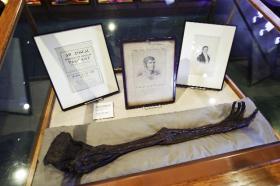The Irish Sporting Heritage Project
Published in 18th-19th Century Social Perspectives, 20th Century Social Perspectives, 20th-century / Contemporary History, General, Issue 6 (Nov/Dec 2009), News, Volume 17
Dan Donnelly’s arm in an exhibition in Boston in 2008 on ‘The Fighting Irish’. Over 70,000 people attended Donnelly’s funeral in 1820; his grave was subsequently robbed and, through a series of circumstances, his right arm was preserved. (Boston College)
Throughout Ireland there are monuments, place-names, pitches and pavilions that convey the story of where and how the Irish played. No inventory of these sites currently exists, however. Sporting sites tell us a great deal about how societies are organised by class, gender, religion and social status. They are linked to the social and cultural landscape and are also often the linchpin of economic development. Sites such as golf courses and race tracks stimulate the local economy and pull economic and infrastructural development towards them.
Health and safety issues as well as commercial considerations have led to the redevelopment of a great deal of Ireland’s sporting heritage. Changes to the landscape are destroying a rich nineteenth- and twentieth-century legacy. The world’s oldest international sports stadium at Lansdowne Road is being completely refurbished and renamed. It was originally a multi-sport ground and included a cinder track for athletics, a cricket pitch, croquet green, three football pitches and facilities for archery and lawn tennis. This is no less a part of Irish heritage than country houses, court houses or holy wells.
Sporting sites matter to people. When the Thomond Park development committee attempted to sell the naming rights of the stadium to the highest bidder in 2007 no sponsor could be found. The hostility of Munster fans to renaming the ground made it an unattractive proposition. The opposition of Shamrock Rovers supporters to the selling of their ground in Milltown in Dublin in 1987 almost bankrupted the club. A memorial has been erected by fans at the former site and demonstrates the importance of the built heritage to communities.
The stories connected to individual sites relate larger stories of social history. Both Fitzgerald Stadium in Killarney and St Dympna’s cricket pitch in Carlow (now no longer in existence) were built using the labour of patients from local mental hospitals. The Henry Ford factory in Cork was built on the site of the old race track. When Kilkee greyhound track opened in 1936 the Clare Champion reported that the crowd applauded loudly, as ‘For a very large number of those present it was the first experience they had of the electric hare’. In 1943 the GAA pitch at the Mardyke in Cork shattered the record attendance for a club match in Ireland when 15,000 people turned out to see the Barr’s and the Glens play for eighteen bicycles in the Augustinian final.
The Irish Sporting Heritage Project will produce an on-line database searchable by sport and by county. A website currently allows members of the public to submit information to the project. We are looking for information on sporting sites from all social classes and traditions. We are also keen to receive information on sites that are no longer used for sport but continue to hold a special meaning in local or national memory. Outreach from the project is incorporating schools projects and will link with those working in universities, archives and museums. Nevertheless, the project also needs the support of sports clubs and sporting fans throughout the country.
If you would like to contribute to the Irish Sporting Heritage Project, simply take a photograph of a sporting site and upload it with information to the website. Alternatively, if you have more extensive information on any aspects of Ireland’s sporting heritage (photographs, programmes, architectural plans or stories) please contact us.
















